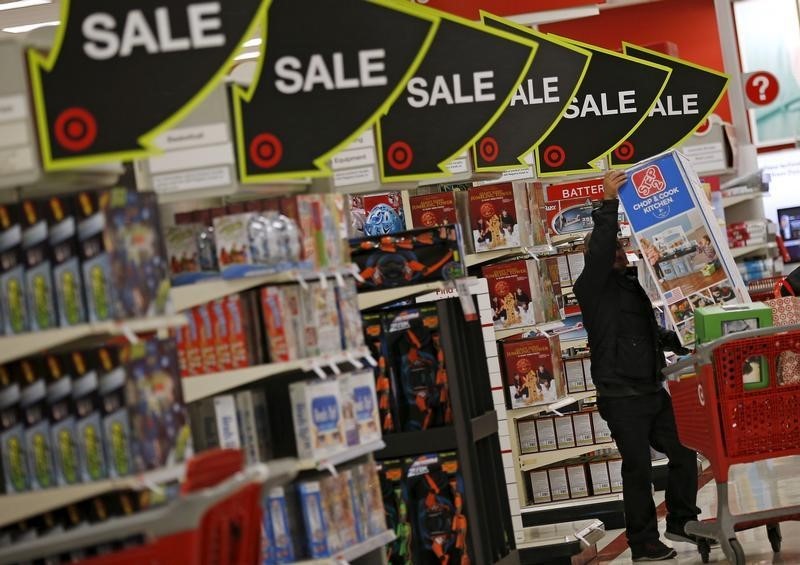By Lucia Mutikani
WASHINGTON (Reuters) - U.S. economic growth braked sharply in the first quarter to its slowest pace in two years as consumer spending softened and a strong dollar continued to undercut exports, but a pick-up in activity is anticipated given a buoyant labor market.
Gross domestic product increased at a 0.5 percent annual rate, the weakest since the first quarter of 2014, the Labor Department said on Thursday in its advance estimate. Growth was also held back by businesses stepping up efforts to reduce unwanted merchandise clogging up warehouses.
Cheap oil, which has pressured the profits of oil field companies like Schlumberger (N:SLB) and Halliburton (N:HAL), remained a drag, sending business spending tumbling at its quickest pace since the second quarter of 2009, when the recession ended.
Almost all sectors of the economy weakened in the first quarter, with housing the lone star.
"The economy essentially stalled in the first quarter, but that doesn't mean it is faltering," said Joel Naroff, chief economist at Naroff Economic Advisors in Holland, Pennsylvania. "Some of the restraints to growth are dissipating. Growth is likely to accelerate going forward."
The dollar's rally is largely over, oil prices appear to be stabilizing and the bulk of the inventory liquidation is out of the way. In addition, the jobs market remains fairly robust.
A separate report from the Labor Department showed first-time applications for unemployment benefits rose less than expected last week and the four-week average of initial claims fell to its lowest level since 1973.
Employment gains averaged 209,000 jobs per month in the first quarter. Also suggesting a pickup in growth in the second quarter, the Institute for Supply Management's manufacturing and nonmanufacturing surveys, which are closely correlated to economic activity, rebounded in recent months.
While the Federal Reserve on Wednesday acknowledged economic activity had "slowed," it also said labor market conditions had "improved further." The U.S. central bank appeared to view the threats from the global economy and financial markets as having diminished.
The Fed left its benchmark overnight interest rate unchanged and suggested it was in no hurry to tighten monetary policy further. It hiked rates in December for the first time in nearly a decade.
Economists had forecast the economy expanding at a 0.7 percent rate in the January-March period after growing at a 1.4 percent pace in the fourth quarter.
U.S. financial markets were little moved by the data as investors digested the Bank of Japan's decision overnight to hold off on expanding monetary stimulus. The dollar fell against the yen and U.S. stocks were trading slightly lower. Prices for U.S. government debt slipped.
SEASONAL QUIRK
Though the weakness in growth last quarter was broad-based, economists believe the model used by the government to strip out seasonal patterns from data is not fully accomplishing its goal despite steps last year to address the problem.
Residual seasonality has plagued first-quarter GDP, with growth underperforming in five of the last six years since the recovery started in mid-2009.
Consumer spending, which accounts for more than two-thirds of U.S. economic activity, increased at a 1.9 percent rate. That was the slowest in a year and marked a deceleration from the fourth quarter's 2.4 percent rate.
Households have been frugal, cutting back on purchases of long-lasting manufactured goods like automobiles, despite cheap gasoline, as they sock away modest wage gains and the gasoline savings. They have also reduced their debt.
Income at the disposal of households after accounting for taxes and inflation increased 2.9 percent in the first quarter after rising 2.3 percent in the prior period. Savings rose to a lofty $712.3 billion from $678.3 billion in the fourth quarter.
"Consumer spending will rebound in the second quarter on the basis of solid growth in income and lower energy costs, which are an under-appreciated tailwind that could offset much of the drag from weak global growth," said Kevin Cummins (NYSE:CMI), senior economist at RBS (LON:RBS) in Stamford, Connecticut.
Businesses continued to place fewer orders for goods in the first quarter, accumulating $60.9 billion worth of inventory, down from $78.3 billion in the fourth quarter.
The small inventory build cut 0.33 percentage point from first-quarter GDP growth.
Trade subtracted 0.34 percentage point from GDP growth, with dollar strength weighing on exports and sucking in imports.
The dollar gained 20 percent versus the currencies of the United States' trading partners between June 2014 and December 2015. So far this year the dollar is down 2.6 percent on a trade- weighted basis.
A sustained plunge in energy sector investment undermined business spending. Equipment spending tumbled at an 8.6 percent rate, the steepest decline since the second quarter of 2009.
Investment in nonresidential structures dropped at a 10.7 percent pace as spending on mining exploration, wells and shafts collapsed at a record 86 percent rate after contracting at a 39.6 percent pace in the fourth quarter. Economists said sluggish business spending suggested productivity will remain weak.

"It makes no sense that companies slashed capital spending but boosted payrolls in the first quarter," said John Ryding, chief economist at RDQ Economics in New York. "The data portend another very weak productivity report for the quarter."